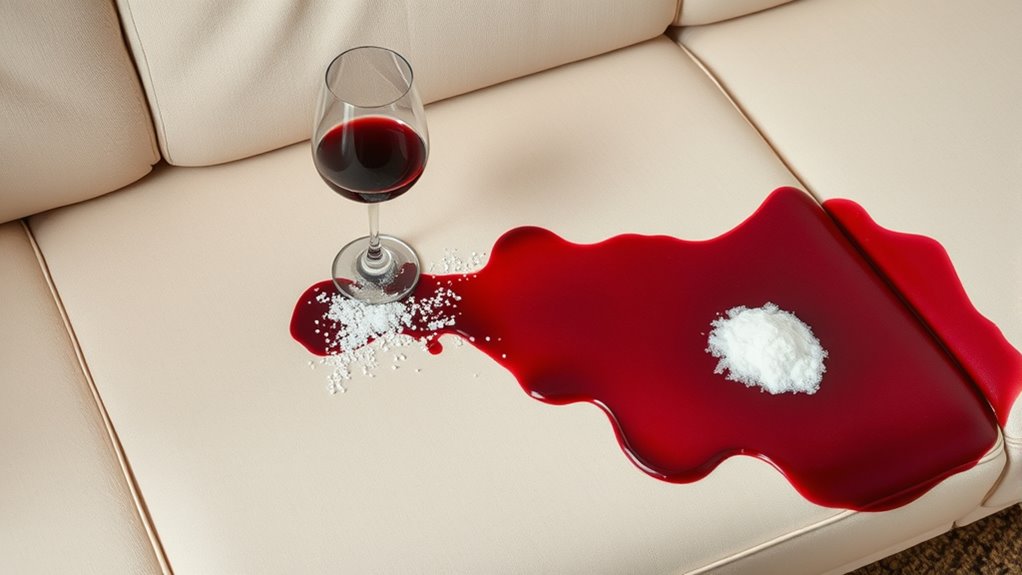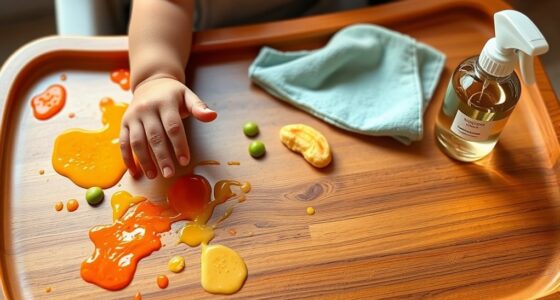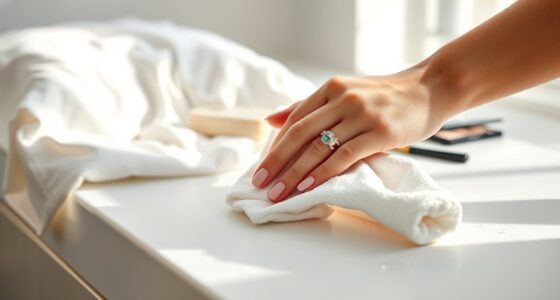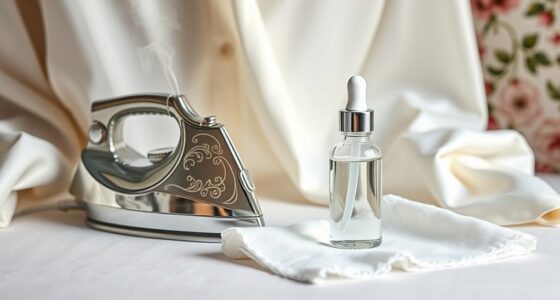If you spill wine on your couch, act fast! Blot the spill gently with a clean cloth, avoiding any rubbing. Pour a bit of white wine or use club soda to dilute the red stain. For tougher stains, mix dish soap and cold water to apply. Don’t forget to sprinkle salt or baking soda for added absorption. Testing any cleaner on a hidden spot first is a smart move. Keep going to discover more effective tricks for tough stains!
Key Takeaways
- Blot the spill immediately with a clean cloth to absorb excess wine without rubbing the fabric.
- Pour white wine or club soda over the stain to dilute it, then blot again.
- Sprinkle salt over the stain and leave it overnight to absorb moisture and pigment.
- Mix dish soap with cold water and gently apply to the stain for additional cleaning.
- For stubborn stains or odors, consider seeking professional cleaning assistance for effective results.
Immediate Steps to Take After a Spill

When wine spills on your couch, every second counts. Act quickly to prevent that stain from setting in.
First, grab a clean cloth or paper towel and gently blot the spill—don’t rub! Blotting absorbs the wine without pushing it deeper into the fabric. If the stain’s large, you might need more advanced cleaning techniques later. Speed is crucial to avoid stubborn stains, as wine dries and bonds to fabric.
Stay calm; panic only delays your response. For immediate relief, you can use club soda or white wine to dilute the stain. DIY solutions like vinegar and dish soap can also help.
Effective Use of Salts and Powders

Salt and absorbent powders can be your best friends in tackling wine stains on upholstery. Start by sprinkling salt generously over the stain, ensuring full coverage to maximize its absorbent properties. For severe stains, leave the salt on overnight to allow it to do its magic. Once done, simply vacuum it off to remove both the salt and the stain. Baking soda and talcum powder can also be effective; just apply them immediately after blotting the excess wine. Let them sit for a few minutes before vacuuming. Baking soda is especially great for eliminating lingering odors, as it can absorb wine and pigment. These methods are easy, cost-effective, and gentle on your upholstery, making them perfect quick fixes for wine mishaps.
Liquid Remedies for Red Wine Stains

If you find yourself dealing with a fresh red wine stain, several liquid remedies can quickly come to your rescue.
Start by pouring white wine on the stain; it neutralizes the red wine. Alternatively, mix washing-up liquid with cold water and gently apply it, blotting until absorbed.
For tougher stains, create a solution of hydrogen peroxide and detergent, applying it before rinsing. Club soda can also help—just pour it over the stain and blot repeatedly.
If all else fails, apply boiling water to the stain, repeating as needed. Acting quickly is crucial to increase the chances of successful removal.
Stain Removal Techniques for Upholstery

Although stains on upholstery can be intimidating, knowing the right removal techniques can make all the difference. Start by checking your upholstery’s care label for specific cleaning instructions. Always blot stains gently with a clean, white cloth; rubbing can push the stain deeper. The sooner you act, the better—wine stains can set within 24 hours. Additionally, quick action on spills minimizes the risk of stubborn stains forming. Test any cleaning solution on an inconspicuous area before applying it to the stain. Avoid over-saturating the fabric, and let it air dry naturally after cleaning. For wine stains, consider using a vinegar-based solution or sprinkling salt to absorb excess liquid. Keep cleaning supplies handy to tackle spills immediately, preventing them from becoming stubborn stains.
Combination Methods for Enhanced Stain Removal

Combining various stain removal methods can greatly boost your chances of success when tackling wine spills on upholstery.
Start by blending home remedies like baking soda and white vinegar; their chemical reaction works wonders. You can also mix club soda with dish soap for an effective cleaning solution. Quick action is crucial, as it greatly influences the stain’s permanence. For better absorption, apply salt before using club soda. If you’re dealing with tough stains, try a paste of salt and baking soda for deeper penetration.
Incorporating natural products like white wine or milk can help absorb the stain before other treatments. Additionally, consider combining commercial cleaners with home remedies, such as using OxiClean with baking soda for those stubborn spots.
Experiment with these combinations to enhance your stain removal efforts!
Advanced Techniques for Tough Stains

When tackling tough wine stains, employing advanced techniques can make a significant difference in your success.
Start by pre-treating the stain with a specialized commercial stain remover designed for your fabric type. If you prefer a natural approach, use absorbents like salt or baking soda to lift the stain. Dehydration can also be a concern, so ensure you’re hydrating adequately while cleaning. Additionally, regular grooming can help minimize the amount of fur transferred to your couch during the cleaning process. Be mindful that some cleaning products may contain essential oils that can irritate sensitive skin. Furthermore, consider the broader environmental impact of your cleaning choices, as some products may contribute to air pollution.
For stubborn marks, try an enzyme-based cleaner or a mix of dish soap and hydrogen peroxide. Remember, avoid heat sources, as they can set the stain permanently.
Always apply cleaners gradually, working from the outside in to prevent spreading. If the stain persists, don’t hesitate to seek professional cleaning assistance for your couch.
You’ll be glad you took these extra steps for a clean finish!
Importance of Spot Testing

Why is spot testing so essential before tackling a wine stain on your couch? It helps you avoid damaging your fabric.
Different materials react differently to cleaning products, and a method that works well on one fabric might ruin another. For instance, delicate silk can be harmed by harsh chemicals, while cotton might still discolor. By testing a hidden area first, you can see if the cleaner causes discoloration or texture changes without risking visible damage. Remember to apply only a small amount and wait a few minutes to observe any reactions. Additionally, using air purifiers can help reduce allergens that may exacerbate the situation. Understanding the fabric composition can further enhance the effectiveness of your cleaning approach, especially if you consider energy efficiency in your home maintenance practices.
Spot testing guarantees you effectively remove the stain without compromising your couch’s integrity, keeping it looking its best for years to come. Additionally, the best overall cleaner identified in recent research is a blend of hydrogen peroxide and Dawn liquid soap, which highlights the importance of using effective methods for optimal results.
When to Seek Professional Help

After you’ve tested your cleaning method on a hidden spot, it’s important to know when to call in the professionals. If the stain’s aged or complex, like wine mixed with food, it’s better left to experts. Delicate fabrics, such as silk or velvet, also require specialized care. If your DIY attempts fail or you’re dealing with a big spill, don’t hesitate to reach out for help. Professionals have advanced cleaning technology and chemical expertise that you mightn’t have. Plus, they can effectively tackle stubborn odors and guarantee your fabric remains intact. Remember, acting quickly is vital; waiting too long can make the stain permanent. When in doubt, seek professional assistance for assured results.
Frequently Asked Questions
Can I Use White Wine to Remove Red Wine Stains?
You can use white wine to tackle red wine stains, but it’s not a guaranteed solution.
While it may help lighten the stain due to its enzymes, it can also leave behind its own residue. Instead of relying solely on white wine, consider alternatives like club soda or baking soda for better results.
Remember to blot the stain immediately and avoid scrubbing, as that could make the situation worse.
What Fabrics Are Most Resistant to Red Wine Stains?
When it comes to fabrics resistant to red wine stains, you’ll want to contemplate leather, vinyl, and microfiber.
These materials have natural or treated properties that help repel liquids. Synthetic fibers like polyester and nylon also resist stains effectively.
Look for tightly woven or non-porous surfaces, as they prevent wine from seeping in. Regular maintenance and stain protection coatings can further enhance their resistance, keeping your fabrics looking great longer.
How Can I Prevent Future Wine Spills on My Couch?
To prevent future wine spills on your couch, consider using stain-resistant fabrics and investing in washable slipcovers.
Set up a designated tasting area with coasters and mats to catch minor spills.
Pour your wine only one-third full to minimize risks.
Keep essential cleaning supplies nearby, like baking soda and vinegar, for quick action if accidents happen.
Regularly vacuuming and deep cleaning your couch will help maintain its freshness and resilience against stains.
Are There Any Natural Remedies for Wine Stains?
When it comes to wine stains, you’ve got a few tricks up your sleeve.
Think of it like fighting fire with fire; white vinegar and baking soda can lift stains effectively. If the spill’s fresh, sprinkle salt to absorb the wine.
Club soda’s carbonation works wonders, too. For tougher stains, a paste of baking soda and water can save the day.
Just remember to blot, don’t scrub, to keep the fabric intact!
What Should I Do if the Stain Reappears After Cleaning?
If the stain reappears after cleaning, don’t panic!
Start by re-evaluating your cleaning method. You might need to apply a stronger solution or try a different technique, like using club soda or a vinegar mixture.
Make sure you thoroughly blot the area and avoid heat, which can set the stain. If it persists, consider seeking professional help.
Regular maintenance and applying fabric protectors can also prevent future issues. Keep those cleaning supplies handy!
Conclusion
So, the next time you find yourself dealing with a wine spill on your couch, remember it’s not the end of the world—it’s more like a hiccup in a great dinner party! Just like a good friend who helps you clean up after a misstep, the right techniques can turn a disaster into a success story. With a bit of quick action and the right remedies, you can restore your couch to its former glory and keep the good times rolling.









